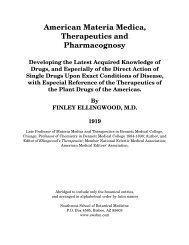SCARLET FEVER. Synonyms.—Scarlatina; Scarlet Rash. Definition ...
SCARLET FEVER. Synonyms.—Scarlatina; Scarlet Rash. Definition ...
SCARLET FEVER. Synonyms.—Scarlatina; Scarlet Rash. Definition ...
Create successful ePaper yourself
Turn your PDF publications into a flip-book with our unique Google optimized e-Paper software.
color, or clear, with more or less flocculent material mixed with it.<br />
Occasionally the abscess exhibits no tendency to point, but the pus<br />
burrows in the tissues for a long time, unless it is opened. In other cases,<br />
when the pus is discharged, the abscess does not heal, but continues to<br />
discharge a dirty flocculent pus; and if we examine it, we will find the<br />
walls ragged and often a chain of lymphatic glands dissected out and<br />
lying at the bottom.<br />
The constitutional disturbance varies greatly. Sometimes there is quite a<br />
brisk febrile action when inflammation first comes up, with loss of<br />
appetite, arrest of secretion, and much prostration. In these cases<br />
suppuration is frequently marked with a chill or rigor, and occasionally<br />
attended by hectic fever and night-sweats. The fever may be very<br />
irregular, assuming either a remittent or intermittent type.<br />
In other cases the only systemic disturbance is the gradual loss of flesh<br />
and strength, derangement of the secretions, a pallid or waxen<br />
appearance, with progressive emaciation. With the enlargement of the<br />
cervical glands the post-cervical, supraclavic-ular, and the maxillary<br />
may also become involved.<br />
Tracheo-Bronchial.—This form is usually preceded by a catarrhal<br />
condition of the bronchial tubes, and may be primary or secondary to<br />
pulmonary infection; the primary form being especially common in<br />
children, Northrup recording affection of the lymph glands in every one<br />
of his one hundred and twenty-seven cases examined in the New York<br />
Foundling Hospital.<br />
These glands are the catch-basins for the various debris which have<br />
escaped the destructive action of bronchial and pulmonary phagocytes;<br />
consequently, they become frequently infected, and undergo changes<br />
similar to those of the cervical glands; namely, become swollen,<br />
tumefied, and finally caseate or calcify.<br />
In the advanced stage there is a tendency to form abscesses, which may<br />
rupture into the lung, bronchi, or trachea. These glands may assume<br />
quite a large size, though they rarely ever produce pressure sufficient to<br />
impair respiration.<br />
Symptoms.—The general symptoms are those of impaired or enfeebled<br />
vital force. There is a progressive decrease in flesh and strength, and<br />
the general condition is well described as “going into a decline.” If<br />
The Eclectic Practice of Medicine - PART I - Infectious Diseases - Page 191

















